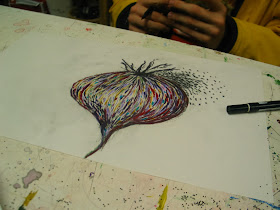Grade Level: Elementary and Middle School
Objective: To "see" the effects of friction through a series of hands-on experiment
Experiment 1:
1-Take two pieces of paper
2-Crumple up one of the pieces of paper
3-Stand on a chair and drop both pieces
4-Which falls fastest? Why?
1-Take two large paperback books (100+ pages)
2-Interlace the pages from both books together
3-Continue to lace the pages together until they're all combined
4-Try to pull the books apart. What happens? Why?
Experiment 3:
1-Fill a water bottle with rice
2-Stick a chopstick in the rice, pull it out. How easy is it?
3-Tap the water bottle, till the rice settles. Then add more rice.
4-Stick the chopstick into the rice again. Try to pull it out. What happens? Why?
 |
| Lacing book pages together |
 |
| Preparing experiments |
 |
| Holding a water bottle up by a chopstick |
 |
| We also experimented with this toy car, sending it down the ramp with different levels of friction |




























